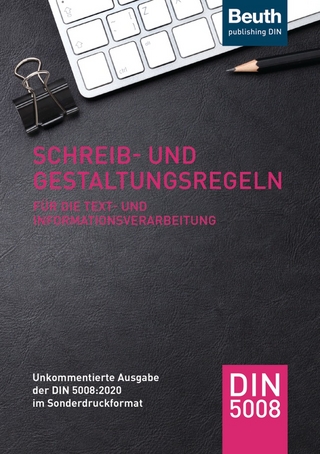
New Worlds: An Introduction to College Reading
McGraw Hill Higher Education (Verlag)
978-0-07-351350-8 (ISBN)
CONNECT READING provides a personalized learning plan for each student, continually developed and refined as students achieve mastery. Each student plan is created through an individualized diagnostic that evaluates skills from 7th-grade level through college-readiness, for second-language learners, international students, adult students, and traditional high-schoolers. Offered completely online, CONNECT READING can be used in conjunction with NEW WORLDS or OPENING DOORS, which provide a printed experience that teaches critical reading skills through close reading of anthologized chapters from best-selling undergraduate texts in Psychology, Sociology, Business, and more.
JANET ELDER was graduated summa cum laude from the University of Texas in Austin with a B.A. in English and Latin. She is a member of Phi Beta Kappa. She was the recipient of a government fellowship for Southern Methodist University's Reading Research Program, which resulted in a master's degree. Her Ph.D. in curriculum and instruction in reading is from Texas Woman's University where the College of Education presented her the Outstanding Dissertation Award. She established the first comprehensive secondary reading program in the Dallas Independent School District, and has conducted extensive staff development training for Dallas area teachers. After teaching reading and study skills courses at Richland for several years, she was asked to develop and implement an honors program for the college. After coordinating the honors program during its first six years, she resumed teaching full time. In addition to teaching reading courses, Dr. Elder periodically serves on interdisciplanary teaching teams for honors English and humanities courses. She has served on a task force that re-evaluated Richland's writing-across-the-curriculum program. She has twice received the Extra Mile Award from special services (disabilities) students, has twice been her division's Piper Award nominee for excellence in teaching, and in 1993 received an Excellence Award from the National Institute for Staff and Organizational Development. In 1999 she was one of three nominees for Richland's Excellence in Teaching Award. A frequent presenter at professional conferences and inservice workshops, she has a deep interest and expertise in brain friendly instruction.
* - New reading selections To the InstructorTo the Student
PART ONE: A NEW WORLD OF LEARNING: READING AND STUDYING IN COLLEGE
CHAPTER 1: INTRODUCTION TO READING AND STUDYING: BEING SUCCESSFUL IN COLLEGENEW INFORMATION AND SKILLS What do you need to know about the reading and studying process?What are the keys to studying college textbooks?What is comprehension monitoring and why is it important?How can you be selective as you read and study?How can you organize as you read and study?How can you rehearse information to remember it?What is the SQ3R study system?How can you adjust your reading rates when you study?How can you improve your reading speed?What do you need to do to be successful in college?Why is it important to set goals?What are learning preferences?Chapter Review CardsHow can you find information online?READINGSSelection 1-1: "A Mother's Answer" from The Big Picture: Getting Perspective on What's Really Important" by Ben Carson and Gregg Lewis (Nonfiction)*Selection 1-2: "Fire Up Your Memory with Proven Strategies!" from Peak Performance: Success in College and Beyond" by Sharon Ferrett(Student Success)*Selection 1-3: "The When and How of Preparing for Tests" from P.O.W.E.R. Learning: Strategies for Success in College and Life by Robert S. Feldman(Study Skills)
CHAPTER 2: DEVELOPING A COLLEGE-LEVEL VOCABULARY: A NEW WORLD OF WORDSNEW INFORMATION AND SKILLSWhy is it important to develop a college-level vocabulary?What are context clues and how do you use them?What are word-structure clues and how do you use them?How do you use a dictionary pronunciation key?What is figurative language and how do you interpret figures of speech? Other things to keep in mind when developing your college-level vocabulary.The most common and helpful roots, prefixes, and suffixes in English come from Latin and ancient Greek.A word’s etymology (origin and history) indicates the word parts it was created from, including Latin orCertain punctuation marks in a sentence can signal a definition.Chapter Review CardsTest Your Understanding: Using Context Clues, Part 1Test Your Understanding: Using Context Clues, Part 2Test Your Understanding: Using Word-Structure Clues, Part 1Test Your Understanding: Using Word-Structure Clues, Part 2Test Your Understanding: Interpreting Figurative Language, Part 1Test Your Understanding: Interpreting Figurative Language, Part 2READINGS*Selection 2-1: "Overwhelming Obstacles" from Peak Performance: Success in College and Beyond by Sharon Ferrett (Student Suscess>*Selection 2-2: "Autism: A Public Health Emergency" from selected Internet Sources (Public Health)*Selection 2-3: "Thinking in Pictures: Autism and Visual Thought" from Thinking in Pictures: My Life with Autism by Temple Grandin
PART TWO: A NEW WORLD OF UNDERSTANDING: USING CORE COMPREHENSION SKILLS WHEN YOU READ COLLEGE TEXTBOOKS
CHAPTER 3: DETERMINING THE TOPICWhat is the topic of a paragraph, and why is it important?What are the clues for determining the topic of a paragraph?Clue 1: Look for a Heading or Title That Indicates the TopicClue 2: Look for a Word, Name, or Phrase in the Paragraph That Appears in Special PrintClue 3: Look for a Word, Name, or Phrase That Is Repeated throughout the ParagraphClue 4: Look for a Word, Name, or Phrase Referred to throughout the Paragraph by Pronouns or Other WordsOther things to keep in mind when determining the topicYou should use a name, word, or phrase, but never a sentence, to express the topic. This means you must know the difference between a phrase and a sentence.You must know the difference between “general” and specific.”A longer passage has an overall topic.Checkpoint: Determining the TopicChapter Review CardsTest Your Understanding, Determining the Topic, Part OneTest Your Understanding: Determining the Topic, Part Two READINGS*Selection 3-1: "Parenting Style: Does it Matter?" from Human Development by Diane Papalia, Sally Olds, and Ruth Feldman (Human Development)Selection 3-2: "Giving a Speech? If You’re Nervous, You’re Normal!" from Public Speaking for College and Career by Hamilton Gregory (Speech Communication)*Selection 3-3: "State-of-the-Art and High-Tech Ways of Dealth" from Understanding Your Health by Wayne Payne, Dale Hahn, and Ellen Lucas(Health)
CHAPTER 4: LOCATING THE STATED MAIN IDEA NEW INFORMATION AND SKILLSWhat is a stated main idea sentence, and why is it important?What is the method for identifying the stated main idea sentence?Which sentence in a paragraph can be the stated main idea sentence?First Sentence of the ParagraphLast Sentence of the ParagraphA Sentence within the ParagraphOther things to keep in mind when locating the stated main idea sentenceAll stated main idea sentences have certain characteristics in common.Avoid these three common mistakes when locating the stated main ideaSignal words or phrases can help you locate a stated main idea and locate a stated main idea that ispresented as a conclusion. A longer passage often has an overall main idea that is stated, too.Checkpoint: Locating the Stated Main IdeaChapter Review CardsTest Your Understanding: Locating the Stated Main Idea, Part OneTest Your Understanding: Locating the Stated Main Idea, Part Two Readings*Selection 4-1: "Who's the Boss? Leaders, Managers, and Leadership Style" from Understanding Business" by William Nickels, James McHugh, and Susan McHugh (Business)*Selection 4-2: "Arranged Marriage: Adventures and Changes" from Marriages and Families: Intimacy, Diversity, and Strengths by David Olson, John DeFrain, and Linda Skogrand (Marriage and Family)*Selection 4-3: "Concussions: Don't Shrug them Off" from Selected internet sources (Health)
CHAPTER 5: FORMULATING AN IMPLIED MAIN IDEA NEW INFORMATION AND SKILLSWhat is an implied main idea, and why is it important?Three formulas for using information in a paragraph to formulate an implied main ideaFormula 1: Add an Essential Word or Phrase to a Sentence in the Paragraph That Almost States the Main IdeaFormula 2: Combine Two Sentences from the Paragraph into a Single SentenceFormula 3: Summarize Important Ideas into One Sentence or Write One Sentence That Gives a General Inference Based on the DetailsOther Things to Keep in Mind When Formulating an Implied Main Idea SentenceYou must always use a sentence—not just a phrase—to express a formulated main idea. This means you must know the difference between a sentence and a phrase.All formulated (implied) main idea sentences have certain characteristics.A longer passage often has an implied overall main idea that you must formulate, too.Checkpoint: Formulating an Implied Main Idea Chapter Review CardsTest Your Understanding: Formulating an Implied Main Idea, Part OneTest Your Undersanding: Formulating an Implied Main Idea, Part Two READINGSSelection 5-1: Two Artistic Tributes: The Vietnam Memorial and the AIDS Quilt from Living with Art by Rita Gilbert(Art Appreciation)*Selection 5-2: "Companies Struggle with 'Inside Jobs' and Outside Threats" from Management Information Systems for the Information Age by Stephen Haag and Maeve Cummings (Management Information Systems)Selection 5-3: "Avian Flu: A Coming Pandemic?" from Biology by Sylvia Mader (Biology)
CHAPTER 6: IDENTIFYING SUPPORTING DETAILSNEW INFORMATION AND SKILLSWhat are supporting details, and why are they important?What is the method for identifying supporting details?Major and minor detailsOther Things to Keep in Mind When Identifying Supporting DetailsWatch for clues that indicate a list of details.Avoid overmarking your textbook by numbering the supporting details in a paragraph rather than highlighting or underlining them.Listing the details on separate lines in your study notes or on review cards can help you learn the information more efficiently.Checkpoint: Identifying Supporting DetailsChapter Review CardsTest Your Understanding: Identifying Supporting Details, Part OneTest Your Understanding: Identifying Supporting Details, Part Two READINGSSelection 6-1: "Hold It! You Can Recycle That! Recycling: A Twenty-First Century Necessity" from Environmental Science: A Study of Interdependence by Eldon Enger and Bradley Smith (Environmental Science)Selection 6-2: "The Life of Buddha" from The 100: A Ranking of the 100 Most Important People in History by Michael Hart (History)Selection 6-3: "The New Immigrants: Asian Americans and Latinos from Nations to Nations: A Narrative History of the American Republic by James Davidson et al.(History)
CHAPTER 7: RECOGNIZING AUTHORS' WRITING PATTERNS NEW INFORMATION AND SKILLSWhat are authors' writing patterns and why are they important?Transition words that signal the relationship of ideas within sentences and between sentencesFive Common Writing PatternsDefinition patternList patternSequence patternComparison-contrast patternCause-effect patternAdditional Paragraph PatternsDefinition and Example PatternGeneralization and Example PatternLocation or Spatial Order PatternSummary PatternClassification PatternAddition PatternStatement and Clarification PatternOther things to keep in mind when recognizing authors' writing patternsLi
sts and sequences differ in an important way.Avoid identifying every paragraph as having a list pattern.Authors often mix patterns in the same paragraph.A longer selection may contain several patterns and have an overall pattern as well.Checkpoint: Recognizing Authors' Writing PatternsChapter Review CardsTest Your Understanding: Recognizing Authors’ Writing Patterns, Part OneTest Your Understanding: Recognizing Authors’ Writing Patterns, Part Two Reading Selections:*Selection 7-1: "Viruses: Easily Spread and Ever Evolving" from Connect Core Concepts in Health by Paul Insel and Walton Roth (Health)Selection 7-2: The Right to Vote: Valued but Under Utilized from We the People: A Concise Introduction to American Politics by Thomas E. Patterson(Government)*Selection 7-3: "Are you Shopping Smart?" from Personal Finance by Jack Kapoor, Les Dlabay, and Robert Hughes
PART THREE: A NEW WORLD OF READING AND THINKING CRITICALLY
CHAPTER 8: READING CRITICALLY NEW INFORMATION AND SKILLSWhat is critical reading, and why is it important? What is author’s point of view, and how can you determine it?What is author’s purpose, and how can you determine it?What is author’s intended audience, and how can you determine it?What is author's tone and how can you determine it?Other things to keep in mind when reading criticallyYou should avoid seeing the purpose of everything you read as to inform.If the author’s purpose is to persuade you to adopt his or her point of view, you should determine whichside of an issue he or she favors.Understanding the author’s tone will enable you to grasp the true or intended meaning, even when theauthor’s words may appear to be saying something different.There are two forms of irony: irony in tone and irony in situations.Sarcasm and irony are not the same thing.Checkpoint: Reading CriticallyChapter Review CardsTesting Your Understanding: Reading Critically, Part OneTesting Your Understanding: Reading Critically, Part Two READINGSSelection 8-1: From For One More Day by Mitch Albom(Literature)Selection 8-2: "I Never Made It to the NFL" from The Last Lecture by Randy Pausch with Jeffrey Zaslow(Memoir)Selection 8-3: "Dispelling the Myths about Millionaires" from Understanding Business by William Nickels, James McHugh, and Susan McHugh (Personal Business)
CHAPTER 9: THINKING CRITICALLY NEW INFORMATION AND SKILLSWhat is thinking critically, and why is it important? What are facts and opinions, and why is it important to be able to distinguish between them?What are inferences, and why is it important to make them? Other things to keep in mind when thinking criticallyFacts and opinions may or may not appear together.Authors sometimes present opinions in such a way that they appear to be facts.There are other critical thinking skills, such as recognizing propaganda devices and recognizing fallacies, that can also be used to evaluate written material.Checkpoint: Thinking CriticallyChapter Review CardsTest Your Understanding: Thinking Critically: Fact and OpinionTest Your Understanding: Thinking Critically: Making Logical InferencesREADINGSb>*Selection 9-1: "Taboos and Myths about Conflict and Anger" from Marriages and Families: Intimacy, Diversity, and Strengths by George Johnson (Marriage and Family)Selection 9-2: "Planet Under Stress: Curbing Population Growth" from The Living World: Basic Concepts by George Johnson (Biology)*Selection 9-3: "For Better or Worse: Divorce" from Human Development by Diane Papalia, Sally Olds, and Ruth Feldman (Human Development)
PART FOUR: A NEW WORLD OF STUDYING: EFFECTIVE AND EFFICIENT STUDY TECHNIQUES
CHAPTER 10: APPROACHING COLLEGE READING AND STUDYINGNEW INFORMATION AND SKILLSWhat is the three-step process for studying college textbooks?Step 1: Prepare to ReadStep 2: Ask and Answer Questions to Guide Your ReadingStep 3: Review by Rehearsing Your AnswersWhat are textbook features?Chapter Introductions and Chapter ObjectivesChapter OutlinesVocabulary Aids and GlossariesBoxesChapter SummariesStudy Questions and Activities Other Textbook featuresHow can you interpret visuals and graphic aids?How can you interpret visual aids?PhotographsDiagramsMapsCartoonsHow can you interpret graphic aids?Line graphsPie chartsBar graphsFlowchartsTablesOther things to keep in mind when studying textbook material.You will benefit from examining the features in all of your textbooks at the beginning of the semester.Chapter Review CardsTest Your Understanding: Interpreting Graphic AidsREADINGSelection 10-1: "Living with Stress" from P.O.W.E.R. Learning: Strategies for Success in College and Life by Robert Feldman (Student Success)
CHAPTER 11: PREPARING FOR TESTS: STUDY-READING, REHEARSAL, AND MEMORYNEW INFORMATION AND SKILLSHow are rehearsal and memory related?How can you underline, highlight, and annotate your textbooks? How can you take notes from textbooks?Guidelines for OutliningGuidelines for MappingGuidelines for SummarizingGuidelines for following directionsOther things to keep in mind as you prepare for tests by applying Core Comprehension SkillsWhen you study, choose the study techniques (underlining, highlighting, annotating, outlining, mapping, summarizing, making review cards or test review sheets) that (a) are appropriate to the type of material you are studying, (b) correspond with how you will e tested on the material, and (c) best suit your learning style.Learn how to handle outline, summary, and mapped notes questions on standardized reading tests.Chapter Review CardsREADINGSelection 11-1: "Information Technology, The Internet, and You" from Computing Essentials by Timothy O'Leary and Linda O'Leary (Information Technology)
ESSENTIAL SKILLS REVIEW TESTSIntroduction to Essential Skills Review TestsEssential Skills Review Test 1Essential Skills Review Test 2Essential Skills Review Test 3Essential Skills Review Test 4Essential Skills Review Test 5Essential Skills Review Test 6Essential Skills Review Test 7Essential Skills Review Test 8Essential Skills Review Test 9Essential Skills Review Test 10Appendix 1 Glossary of Key TermsAppendix 2 Master Vocabulary List
INDEXInstructor's Guide
| Erscheint lt. Verlag | 16.3.2013 |
|---|---|
| Zusatzinfo | 73 Illustrations, unspecified |
| Verlagsort | London |
| Sprache | englisch |
| Maße | 206 x 252 mm |
| Gewicht | 1164 g |
| Themenwelt | Schulbuch / Wörterbuch ► Erwachsenenbildung |
| Schulbuch / Wörterbuch ► Wörterbuch / Fremdsprachen | |
| Geisteswissenschaften ► Sprach- / Literaturwissenschaft ► Literaturwissenschaft | |
| Geisteswissenschaften ► Sprach- / Literaturwissenschaft ► Sprachwissenschaft | |
| ISBN-10 | 0-07-351350-4 / 0073513504 |
| ISBN-13 | 978-0-07-351350-8 / 9780073513508 |
| Zustand | Neuware |
| Haben Sie eine Frage zum Produkt? |
aus dem Bereich


